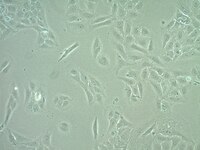SCC293 Sigma-AldrichU2OS EGFP-H2B Human Osteosarcoma Cell Line
Prodotti consigliati
Panoramica
| Replacement Information |
|---|
| References |
|---|
| Product Information |
|---|
| Biological Information | |
|---|---|
| Cell Line Type |
|
| Physicochemical Information |
|---|
| Dimensions |
|---|
| Materials Information |
|---|
| Toxicological Information |
|---|
| Safety Information according to GHS |
|---|
| Safety Information |
|---|
| Product Usage Statements | |
|---|---|
| Quality Assurance | Each vial contains ≥ 1X10⁶ viable cells. Cells are tested negative for infectious diseases by a Human Essential CLEAR panel by Charles River Animal Diagnostic Services. Cells are verified to be of human origin and negative for inter-species contamination from mouse, rat, Chinese hamster, Golden Syrian hamster, and Non-human Primate (NHP) as assessed by a Contamination Clear panel by Charles River Animal Diagnostic Services Cells are negative for mycoplasma contamination. |
| Usage Statement |
|
| Packaging Information | |
|---|---|
| Material Size | ≥1X10⁶ cells/vial |
| Transport Information |
|---|
| Supplemental Information |
|---|
| Specifications |
|---|
| Global Trade Item Number | |
|---|---|
| Numero di catalogo | GTIN |
| SCC293 | 04065266024159 |
Documentation
Scheda tecnica
| Titolo |
|---|
| Data Sheet-SCC293 |








[231270-ALL].jpg)
[231291-ALL].jpg)